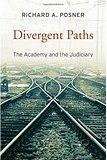
Reviewed by: James G. Apple, Editor-in-Chief, International
Judicial Monitor
In 1936 a prominent Yale law professor named Fred Rodell
(author of a book about the Supreme Court of the United States titled Nine
Men) wrote an article for the Virginia Law Review titled “Goodbye to Law
Reviews” (37 Va.L.Rev. 1785). That was a time when appreciation for law
reviews as training grounds for law students and as readily available outlets
the writings of law professors (“publish or perish”) had reached a zenith.
Professor Rodell’s article achieved a certain amount of fame. because of its unconventional views about these student
publications. Significantly it was included in a compendium of the most
important legal articles of the 20th Century. It was certainly
widely read, not only because of its views about legal writing, but also
because it was very, very funny.
Later, in 1962, the Virginia Law Review published a
sequel to it, appropriately titled “Goodbye to Law Reviews - Revisited” (48 Va.L.Rev.
279 which did not attain the notoriety of the original article. However it was
also very funny, and revealed that Professor Rodell’s disdain for legal writing
had not diminished in the 26 years between publication of the two articles.
In both articles, Professor Rodell takes up two issues which
are central to his complaint. “There are two things wrong with almost all legal
writing,” he wrote. “One is its style. The other is its content. That, I think,
about covers the ground.” One of the characteristics of law review articles is
the almost fanatical use of footnotes in law review articles (and also in many
other types of legal writing). The pomposity of the legal articles is another
one of his targets. He notes for instance that the Blue Book: A Uniform
System of Citation used universally by law professors and law students for
the manner of citation of references in legal articles, especially law review
articles, developed in the early 1920s by professors at Yale and Harvard Law
School, has now expanded to over 500 pages. (When I was in law school and an
editor of the Virginia Law Review in 1961-62 the Blue Book was
probably less than 150 pages.)
Judge Richard Posner, in his new book, has taken up the same
cudgel with which to pound law reviews as well as other aspects of writing and
judging. However his commentary is more penetrating; legal writing is but one of
many subjects which Judge Posner discusses in the new work. In fact the title
of the book is somewhat misleading, because most of the book does not deal with
the relationship between courts and the academy, or between judges and law
professors. It is mainly of critique of the federal courts and federal judges.
Most of the commentary about them is negative. For instance in one place in the
Introduction, he comments: “As I argue in subsequent chapters, the problems of
the judiciary are administrative, operational, structural, attitudinal and
cultural …”. In fact one might conclude from the overwhelming negativity that
is displayed that Judge Posner has lost all objectivity about his subjects. The
federal courts could not be that bad.
In his defense and to answer such criticism, it can be said
that on reflection a serious observer of the U.S. federal legal system would
have to conclude that in a great many instances Judge Posner is correct in his
analysis and critique, and that the federal courts and federal judges would be
better off if his observations were thoughtfully considered and many of his
recommendations were adopted.
Judge Posner has divided his book into two major parts, and
three main subparts for each of the two major divisions. The first division is
titled “Problems of the Modern Judiciary” and has divisions discussing
Structural Deficiencies, Process Deficiencies, and Management Deficiencies. The
second subdivision on processing deficiencies is the most penetrating; it takes
up 147 pages of the 406 page book.
The second major division, titled “The Academy to the
Rescue” is broken up into discussions of The Contribution of Scholarship, The
Law School Curriculum, and Continuing Judicial Education. There is also a Conclusion
and Epilogue.
To give the reader of this review a sense of the depth of
the commentary in these different parts, consider that the Process Deficiencies
section has 17

 International
Judicial Monitor
International
Judicial Monitor